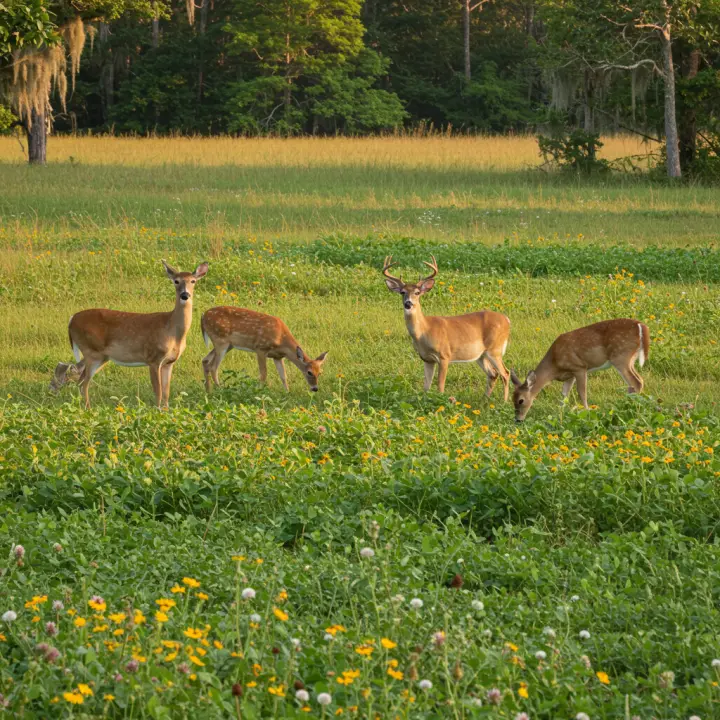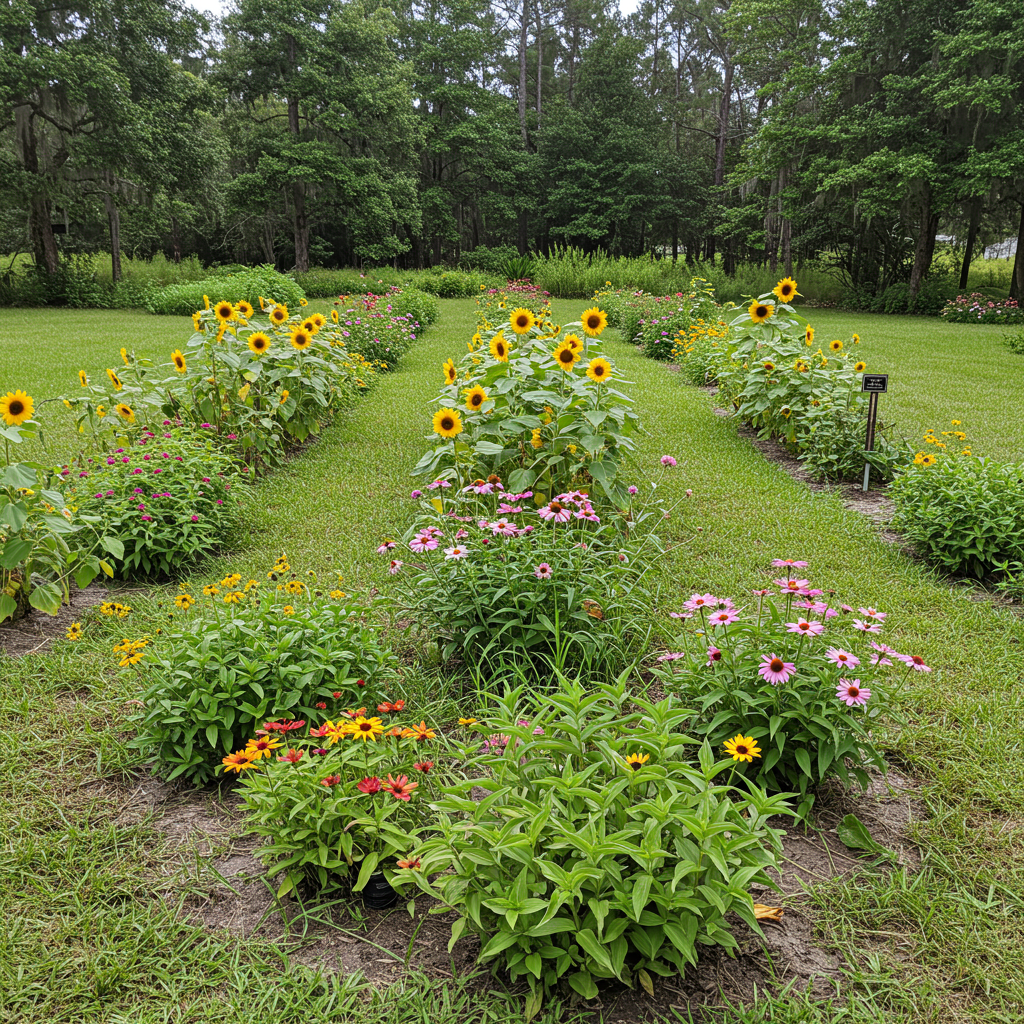Successfully attracting and holding deer on your property starts with the right food source. This guide details the best proven August plantings for Florida deer crops, focusing on heat-tolerant and nutritious options that will thrive in the state’s unique climate and draw in bucks for the upcoming hunting season.
August in Florida presents a unique and critical window for wildlife managers and hunters looking to establish lucious, attractive food plots. The combination of late-summer heat, frequent rainfall, and the approaching hunting season makes this month the perfect time to plant specific crops. These plantings provide essential nutrition during a stressful period for deer and create a powerful draw that can last well into the fall. However, Florida’s sandy soil, intense humidity, and persistent pests can quickly turn a hopeful food plot into a failed investment. This comprehensive guide will walk you through the proven crops that stand up to the Florida challenge, ensuring your efforts result in a thriving food source for your local deer herd.
Why August is a Critical Planting Window in Florida

Planting a food plot is about timing, and in Florida, August is a sweet spot for several key reasons. Understanding why this month is so important will help you maximize your success and appreciate the strategy behind late-summer planting.
Capitalizing on the Rainy Season
Florida’s summer is characterized by its near-daily afternoon thunderstorms. August is typically one of the wettest months of the year across the state. This consistent moisture is a massive advantage for food plotters.
Germination Fuel: Adequate moisture is the single most important factor for successful seed germination. Planting in August almost guarantees your seeds will have the water they need to sprout quickly and establish strong roots without the need for expensive irrigation.
Reduced Risk: Planting during a dry spell is a gamble. By planting in the rainy season, you significantly reduce the risk of your seeds sitting dormant in dry soil or dying shortly after sprouting.
Vigorous Growth: The combination of ample water, warm soil, and long daylight hours encourages rapid, vigorous plant growth. This helps your food plot get established quickly, allowing it to better compete with weeds and withstand early browse pressure.
Getting Ahead of the Hunting Season
Timing your planting for August ensures your food plot reaches peak attractiveness right when you need it most. Deer behavior shifts in the fall, and having a prime food source ready can make or break your hunting season.
A plot planted in August will typically be lush and highly palatable by late September and October, coinciding with the early archery season in many parts of the state. As native vegetation begins to die back and lose its nutritional value in the fall, your green, vibrant food plot will become an irresistible food source. This creates a predictable pattern of deer movement onto your property, giving you a significant advantage.
Bridging the Late-Summer Nutritional Gap
Late summer is a surprisingly stressful time for whitetail deer. Does are still lactating and recovering from the energy demands of raising fawns, while bucks are channeling immense resources into growing antlers. Natural forage can be tough and less nutritious during this period.
An August-planted food plot, rich in protein and essential nutrients, provides a critical bridge during this “nutritional stress” period. By offering high-quality forage like iron clay peas or soybeans, you help improve the overall health of your local deer herd. Healthier does produce healthier fawns, and bucks with access to superior nutrition can express their full genetic potential for antler growth.
Understanding Florida’s Unique Challenges
Before you buy a single seed, it’s crucial to understand that planting in Florida is not like planting in the Midwest or the North. The Sunshine State presents a unique set of challenges that must be addressed for any food plot to thrive.
The Sandy Soil Dilemma
Much of Florida is covered in sandy soil, particularly in the central and southern regions. While excellent for drainage, this soil type presents two main problems:
1. Low Nutrient Retention: Sandy soil has a difficult time holding onto essential nutrients. Fertilizers can leach through the soil profile quickly after a heavy rain, moving them away from the plant’s root zone.
2. Poor Water Retention: While the rainy season helps, during brief dry spells, sandy soil dries out extremely fast. This can stress or kill young seedlings.
Solution: The key to combating sandy soil is building up its organic matter. This can be done by tilling in cover crops like buckwheat or sunn hemp, or by adding compost. Organic matter acts like a sponge, holding both water and nutrients in the root zone where plants can access them.
Intense Heat and Humidity
August in Florida is brutally hot and humid. Many popular food plot species, such as certain types of clover and brassicas, simply cannot handle these extreme conditions. Planting a species not suited for the heat will result in poor germination, stunted growth, and a failed plot. The crops recommended in this guide have been chosen specifically for their ability to tolerate and even thrive in these conditions.
Prolific Pests and Weeds
The year-round growing season in Florida means that pests and weeds are a constant threat. Armyworms, grasshoppers, and various fungal diseases can devastate a young food plot seemingly overnight. Aggressive weed species like cogon grass or crabgrass can quickly outcompete your desired crops for sunlight, water, and nutrients. A proactive approach to weed and pest management, starting with proper ground preparation, is essential.
Top Proven August Plantings for Florida Deer Crops
Now for the main event. These are the go-to, field-tested crops that have proven their worth time and time again in Florida’s challenging environment. Focusing on these species will give you the best chance of success.
The Powerhouse Legumes: Cowpeas & Iron Clay Peas
If you can only plant one thing in August in Florida, make it peas. Cowpeas, and specifically the variety known as Iron Clay Peas, are arguably the king of warm-season deer plots in the South.
Why They Work: Iron Clay Peas are highly drought-tolerant once established, thrive in the heat, and are incredibly attractive to deer. They are legumes, meaning they fix nitrogen in the soil, which benefits future plantings. The “Iron Clay” variety is also more resistant to heavy grazing than other types of cowpeas.
Nutritional Value: They are packed with protein, often exceeding 20-25%. This is exactly what deer need in late summer for antler growth and fawn rearing.
Planting Tips:
Seeding Rate: Broadcast at 50-70 lbs per acre. If drilling, use 30-40 lbs per acre.
Planting Depth: Plant about 1 inch deep.
Fertilizer: They require very little nitrogen. Focus on phosphorus and potassium. A soil test will guide you, but a general recommendation is 0-20-20 fertilizer.
Soybeans: The High-Protein Magnet
Soybeans are another top-tier choice for a
n August planting. Deer find them almost irresistible from the moment they sprout until the last bean pod is consumed.
Why They Work: Like peas, soybeans are a warm-season legume that can handle Florida’s heat. They produce a massive amount of high-protein forage throughout their growth cycle. In the fall, after the leaves drop, the bean pods provide a high-energy food source that is critical for deer heading into the winter.
Nutritional Value: The leaves can contain over 30% protein, and the beans themselves are rich in fat and protein, providing crucial energy.
The Challenge: The biggest issue with soybeans is that deer love them too much. In areas with high deer density, a small plot can be wiped out before it has a chance to establish. They are best suited for larger plots (3+ acres) or properties with a moderate deer population. Using a deer repellent system for the first few weeks can also help.
Planting Tips:
Seeding Rate: Broadcast at 70-80 lbs per acre. Drill at 50-60 lbs per acre.
Planting Depth: 1 to 1.5 inches deep.
Fertilizer: Similar to peas, use a low-nitrogen fertilizer like 0-20-20 or 5-20-20.
Buckwheat: The Fast-Growing Soil Builder
Buckwheat is an excellent choice for hunters who are short on time or are looking to improve their soil quality for future plantings.
Why It Works:** Buckwheat is one of the fastest-growing food plot crops available. It can go from seed to maturity in as little as 60-70 days. This makes it a perfect “instant” food plot. It’s also fantastic at suppressing weeds and is a “phosphorus scavenger,” meaning it pulls phosphorus from the soil and

